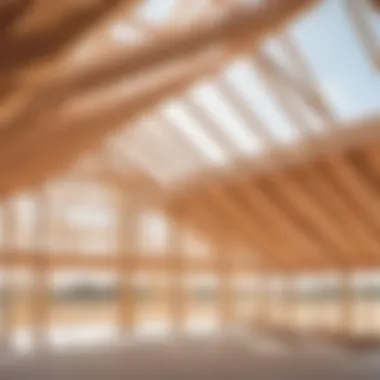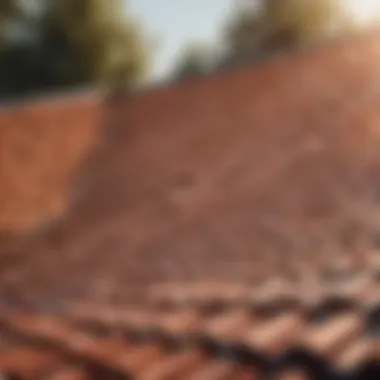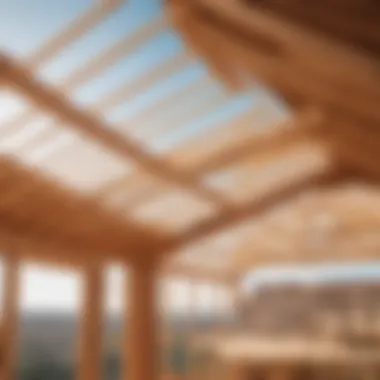Materials:
To kickstart your roofing project, gather the following materials:
- Lumber: Purchase high-quality lumber with precise measurements according to your roof design.
- Roofing Nails: Invest in corrosion-resistant roofing nails to ensure long-term durability.
- Roofing Material: Choose the appropriate roofing material based on your regional climate.
- Roofing Underlayment: Secure a reliable underlayment to shield your roof from moisture infiltration.
- Roofing Tools: Equip yourself with essential tools such as a hammer, circular saw, measuring tape, and safety gear.
DIY Steps:
- Planning: Begin by understanding your roof design and calculating the required materials accurately.
- Cutting Lumber: Use a circular saw to cut the lumber precisely according to your roof's dimensions.
- Assembling Roof Trusses: Carefully assemble roof trusses ensuring proper alignment and structural integrity.
- Installing Roof Sheathing: Secure the roof sheathing using roofing nails to create a sturdy base for your roof.
Technical Aspects:
- Tools: Ensure you have the necessary tools like a framing square, chalk line, and ladders for efficient roof framing.
- Timing: Plan your project timeline considering weather conditions and optimal working hours for increased productivity.
- Critical Techniques: Master techniques like rafter installation and truss bracing for a robust roof structure.
DIY Project Process:


- Laying Out Trusses: Position roof trusses accurately on the walls, following your roof layout plan.
- Securing Trusses: Use braces to secure trusses in place before nailing them to the walls for added stability.
- Installing Fascia Boards: Attach fascia boards along the roof edges to provide a finishing touch to your roof.
- Troubleshooting Tips: In case of misaligned trusses or gaps, adjust them promptly to maintain the roof's integrity.
- Roof Inspection: Conduct a thorough inspection post-installation to verify the structural strength and identify any potential issues.
Types of Roof Structures
Gable Roof
The gable roof is a classic and versatile roofing style characterized by its triangular gable ends. This popular design offers excellent drainage and ventilation properties, making it ideal for various climates. The distinct triangular shape of the gable roof provides ample attic space and allows for easy installation of windows and ventilation openings. While gable roofs are relatively straightforward to construct, they can be prone to wind uplift in high-wind areas, necessitating proper bracing and reinforcement for enhanced stability.
Hip Roof
The hip roof features slopes on all four sides, meeting at a ridge to form a gentle slope. This roofing style is known for its stability and resistance to high winds, making it a popular choice for regions prone to severe weather conditions. The hip roof's evenly distributed slopes offer excellent water drainage and structural support, reducing the risk of leaks and structural damage. This design also provides additional living space in the attic, making it a functional and aesthetically pleasing option for residential buildings.
Gambrel Roof
The gambrel roof, also known as a barn roof, is characterized by its two slopes on each side, with the lower slope being steeper than the upper one. This distinctive design maximizes attic space and provides a vintage charm to the structure. Gambrel roofs are suitable for buildings requiring extra overhead storage or living space, as the steep lower slope allows for increased headroom. While offering a classic appearance and added space, gambrel roofs require careful consideration of structural support and waterproofing to prevent issues like snow accumulation and leaks.
Flat Roof
Flat roofs are modern and minimalist in design, featuring a completely level surface with little to no slope. This sleek and contemporary style is popular for commercial and industrial buildings, offering a practical and cost-effective roofing solution. Flat roofs provide easy access for maintenance and installation of rooftop equipment, making them convenient for utilities and HVAC systems. However, proper drainage and waterproofing are essential considerations for flat roofs to prevent water pooling and potential leaks.
Shed Roof
The shed roof, also known as a single-slope or lean-to roof, is a simple and practical roofing style characterized by its single sloping plane. This minimalist design is ideal for sheds, carports, and extensions, providing a straightforward and efficient roofing solution. Shed roofs are cost-effective to construct and offer flexibility in design, making them a popular choice for smaller structures or modern architectural projects. While shed roofs are relatively easy to install, proper insulation and ventilation must be considered to ensure optimal performance and longevity.
Tools and Materials Required


When it comes to framing a roof, having the right tools and materials is crucial for the success of the project. Each component plays a significant role in ensuring the structural integrity, durability, and safety of the roof. Proper selection of tools and materials not only streamlines the construction process but also contributes to the aesthetics and long-term performance of the roof.
Essential Tools for Roof Framing
Circular Saw
A circular saw is a versatile and essential tool for roof framing. Its precision cutting abilities make it indispensable for shaping rafters, trusses, and other structural elements with accuracy. The circular saw's portability and power allow for quick and efficient cutting, saving valuable time during construction. Its ability to make angled cuts adds versatility to the framing process, enabling complex roof formations with ease.
Hammer
The hammer is a fundamental tool in roof framing, used for driving nails and securing joints. Its ergonomic design and varying head weights make it adaptable to different framing tasks. The hammer's durability and reliability ensure consistent performance throughout the construction project. Its versatility in handling various sizes of fasteners makes it a go-to tool for roof framing professionals.
Level
An essential tool for ensuring precision and alignment in roof framing, the level is vital for maintaining the structure's accuracy and stability. Levels come in different sizes and types, such as bubble levels or laser levels, catering to various framing requirements. Their ability to guide vertical and horizontal alignment prevents errors, guaranteeing a well-constructed roof structure.
Square
The square is a critical tool for achieving perpendicular and angled cuts in roof framing. Its L-shaped design assists in marking and cutting materials at precise angles, essential for creating strong and stable joints. The square's versatility in layout work and checking for squareness ensures that the roof framing is structurally sound and aesthetically pleasing. Its compact size and ease of use make it a must-have tool for roof framing projects.
Step-by-Step Guide to Roof Framing


In this section of the comprehensive guide on framing a roof, we delve into the crucial process of roof framing, breaking it down into a step-by-step approach that ensures precision and structural integrity. Roof framing is a fundamental aspect of any construction project, providing the skeleton on which the entire roof structure rests. This detailed guide aims to equip individuals with the essential knowledge and techniques required for successful roof framing, whether for a new build or a renovation project.
Preparing the Roof Frame
Layout and Measurements
When it comes to preparing the roof frame, the initial step of layout and measurements plays a pivotal role in ensuring accuracy and consistency throughout the framing process. Proper layout and measurements are essential for determining the exact positioning of rafters, trusses, and other structural components, ultimately influencing the stability and integrity of the roof structure. By meticulously planning and measuring each component, builders can avoid errors and discrepancies that could compromise the overall quality of the roof framing. This meticulous attention to detail sets the foundation for a sturdy and well-structured roof that can withstand various external forces and environmental conditions.
Cutting Rafters and Trusses
The process of cutting rafters and trusses involves precision and skill, as these components form the backbone of the roof structure. Each rafter and truss must be cut to the exact measurements and angles determined during the layout phase to ensure a seamless fit and proper weight distribution. Utilizing high-quality tools such as a circular saw and measuring devices, builders can accurately cut the rafters and trusses according to the project specifications. Careful consideration of factors like roof pitch and load-bearing requirements is essential during the cutting process to guarantee the structural strength and durability of the roof frame. While the cutting phase may seem straightforward, it requires a keen eye for detail and a steady hand to execute with precision.
Assembling the Roof Structure
Installing Rafters
Among the key steps in roof framing is the installation of rafters, which provide essential support for the roof system. Installing rafters involves attaching these inclined structural beams to the ridge board or wall plate, forming the basic framework of the roof. The proper positioning and securing of rafters are critical to distributing the roof load evenly and maintaining structural integrity. Builders must ensure that each rafter is securely fastened and aligned according to the design plans to prevent any potential issues such as sagging or uneven weight distribution. By following a systematic approach to rafter installation, builders can create a robust and reliable roof structure that meets safety and performance standards.
Attaching Trusses
In the process of attaching trusses, builders strategically connect these prefabricated triangular frameworks to the existing roof frame, reinforcing the overall stability and load-bearing capacity of the structure. Trusses play a significant role in supporting the roof and transferring loads to the walls or columns, making their proper attachment essential for ensuring structural strength. By carefully positioning and fastening the trusses according to the engineering specifications, builders can create a resilient framework that can withstand the pressures of varying weather conditions and external elements. Attention to detail and adherence to safety guidelines are crucial during the truss attachment process to guarantee the long-term performance and durability of the roof system.
Adding Sheathing and Roofing Materials
Installing Roof Sheathing
With the roof structure taking shape, the next step involves installing roof sheathing, which acts as a protective layer and adds rigidity to the roof assembly. Roof sheathing serves as a base for the roofing materials, providing a flat surface for shingles or other covering options while enhancing the overall strength and stability of the roof structure. Proper installation of roof sheathing involves securely attaching the panels to the rafters or trusses, ensuring uniform coverage and alignment across the roof surface. Builders must pay attention to nailing patterns, panel overlaps, and edge sealing to create a weather-resistant barrier that shields the underlying framework from moisture and external elements.
Applying Roofing Materials
The final stage of roof framing involves the application of roofing materials, which not only contribute to the aesthetic appeal of the structure but also offer protection against weather elements and insulation properties. Roofing materials such as asphalt shingles, metal panels, or tiles are selected based on factors like climate, budget, and desired appearance. Careful installation of roofing materials is essential for achieving a watertight and durable roof covering that enhances the overall efficiency and longevity of the roof system. By following manufacturer guidelines and best practices for roofing installation, builders can ensure a high-quality finish that elevates the visual appeal and performance of the completed roof.
Tips for Efficient Roof Framing
Efficient roof framing is crucial to the structural integrity, longevity, and aesthetics of your roof. In this comprehensive guide on framing a roof, we delve into essential tips to ensure a successful roofing project. From accurate measurements to proper ventilation and structural stability, following these tips can make a significant difference in the outcome of your roof framing.
Maintaining Accuracy in Measurements
Double-Check Dimensions:
Double-checking dimensions is a fundamental aspect of roof framing that cannot be overlooked. In this guide, we emphasize the importance of precision in measurements to avoid costly mistakes and ensure a secure roof structure. The key characteristic of double-checking dimensions is the ability to catch any errors before they impact the construction process. By paying attention to details and verifying measurements, you can mitigate risks and enhance the overall quality of your roof framing. While double-checking dimensions may seem time-consuming, the benefits of accuracy far outweigh the slight additional effort required. It serves as a safeguard against inaccuracies that could lead to structural issues down the line, making it a popular choice for meticulous builders seeking perfection in their projects.
Use Precision Tools:
The use of precision tools is imperative in achieving accurate and reliable measurements during roof framing. Precision tools such as levels, squares, and measuring tapes play a vital role in ensuring that every cut and placement aligns perfectly with the design plans. The key characteristic of precision tools lies in their ability to offer exact measurements, promoting consistency and quality in the construction process. By incorporating precision tools into your roof framing endeavors, you benefit from increased productivity, reduced errors, and enhanced precision. While precision tools may require an initial investment, their advantages in terms of improved accuracy and efficiency make them indispensable for achieving exceptional results in roof framing projects.
Ensuring Proper Ventilation
Include Ventilation Channels:
Proper ventilation is essential for maintaining a healthy and functional roof structure. When it comes to roof framing, including ventilation channels allows for the proper airflow and moisture control within the roof assembly. Ventilation channels facilitate the movement of air, reducing the risk of moisture buildup and condensation, which can lead to mold growth and structural damage. The unique feature of ventilation channels is their ability to create a continuous airflow pathway, promoting optimal ventilation throughout the roof system. While ventilation channels may require additional planning and installation, their benefits in improving roof longevity and performance make them a valuable addition to any roof framing project.
Use Ridge Vents:
Ridge vents offer an effective solution for enhancing roof ventilation and mitigating heat buildup in the attic space. In this guide, we emphasize the benefits of using ridge vents in roof framing to promote energy efficiency and comfort within the building. Ridge vents are designed to sit atop the roof ridge, allowing hot air to escape and fresh air to enter, creating a balanced airflow system. The unique feature of ridge vents is their unobtrusive design, blending seamlessly with the roofline for a polished finish. While ridge vents may require professional installation and upfront costs, their advantages in improving air circulation and preventing moisture-related issues justify their inclusion in roof framing projects.
Inspecting for Structural Stability
Check for Sagging:
Inspecting for sagging is a critical step in ensuring the structural stability and safety of your roof. By examining the roof for any signs of sagging or unevenness, you can detect potential issues early on and address them before they escalate. The key characteristic of checking for sagging is its ability to identify load-bearing deficiencies or structural weaknesses that could compromise the integrity of the roof system. Regular inspections for sagging are recommended to maintain a robust and secure roof structure, prolonging its lifespan and minimizing the risk of structural failure. While checking for sagging requires vigilance and attention to detail, the prevention of serious structural issues makes it a prudent choice for conscientious homeowners investing in the longevity of their roof.
Inspect for Leaks:
Leak inspection is a fundamental aspect of roof maintenance that should not be overlooked in the context of roof framing. In this guide, we highlight the importance of inspecting for leaks to prevent water damage and ensure the durability of your roof. By identifying and addressing leaks promptly, you can protect the underlying structure from moisture infiltration and potential decay. The unique feature of leak inspections is their proactive nature, allowing homeowners to detect and resolve issues early, minimizing repair costs and structural damage. While leak inspections require periodic checks and maintenance, the benefits of preserving the integrity and reliability of your roof justify the time and effort invested in this essential task.





